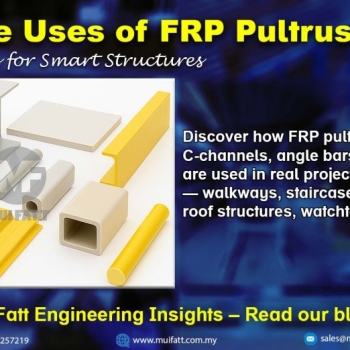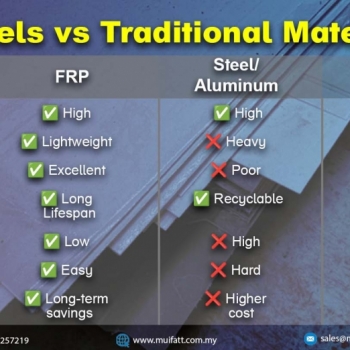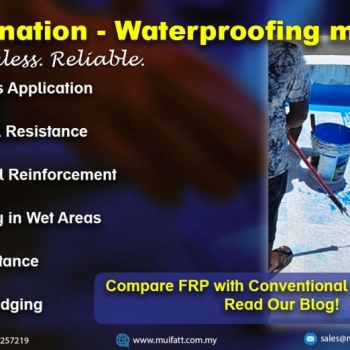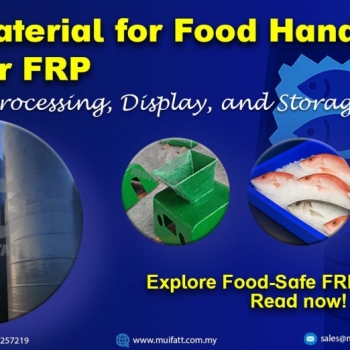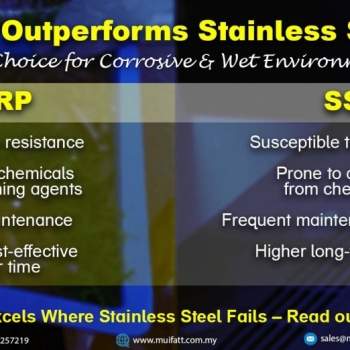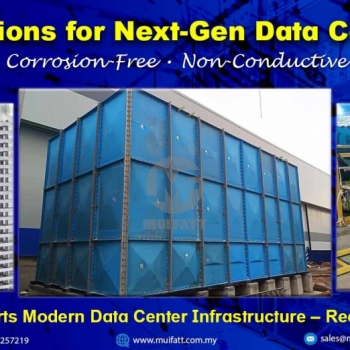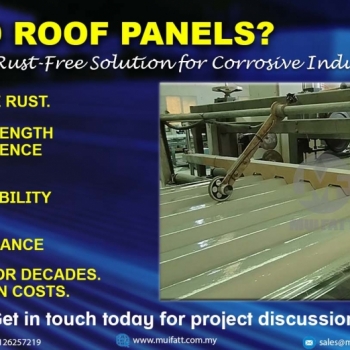FRP pultruded profiles are reshaping structural possibilities across Malaysia. From STP staircases to public park shelters, explore how these modular components enable custom FRP solutions—only from Mui Fatt.
Mui Fatt Engineering Insights - FRP Panel Tank Installation
11 Jun 2025
- Key Takeaways
- Tools Required for Panel Tank Assembly
- Step-by-Step FRP Panel Tank Installation Process
- Why Choose Mui Fatt’s FRP Tanks?
- Frequently Asked Questions (FAQs)
Key Takeaways
-
A structured and safe method is essential for sectional FRP tank assembly.
-
Proper sequence of installation enhances tank durability and water tightness.
-
External supports and sealant application are critical for long-term performance.
FRP sectional panel tanks are widely used for water storage in commercial, industrial, and municipal projects. Whether you’re preparing for new installations or understanding existing systems, a structured guide can help ensure proper setup and performance. This article outlines the common and recommended panel tank installation method employed by Mui Fatt, a trusted manufacturer of FRP tanks in Malaysia.
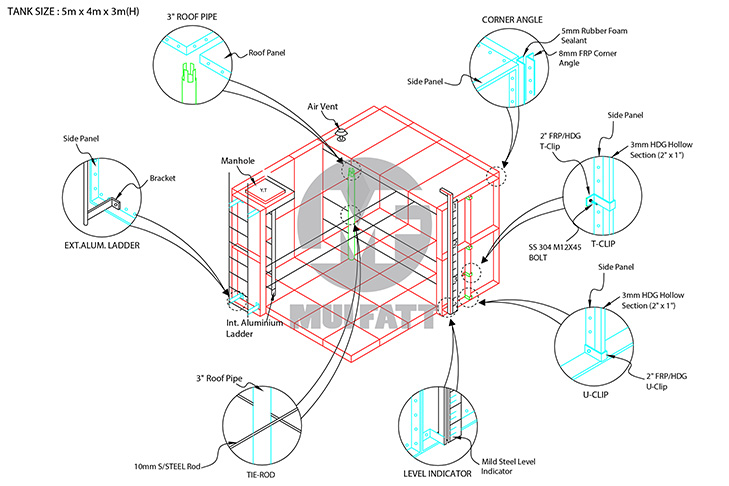
Tools Required for Panel Tank Assembly
Before beginning the installation, prepare these tools:
-
2x 19mm spanners (open-end or ring)
-
2x sharp knives
-
2x hammers
-
2x hole alignment bars
-
2x torque wrenches
-
1x electric percussion spanner with 19mm socket
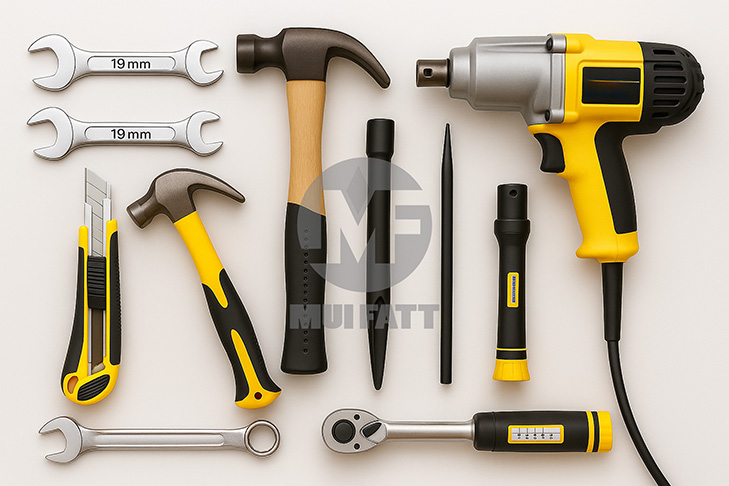
Step-by-Step FRP Panel Tank Installation Process
(Based on Mui Fatt's Standard Practice)
Before You Begin, make sure to read the full panel tank assembly drawing and verify the concrete plinth layout and curing status. All tools and parts should be prepared and checked against the delivery order and packing list.
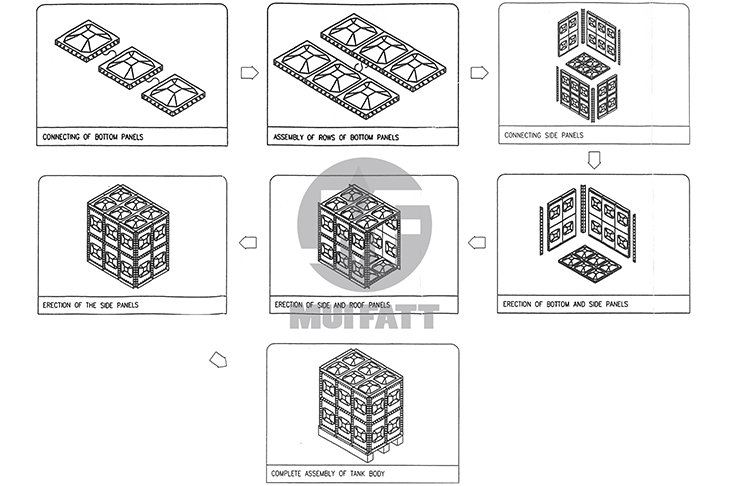
Step 1: Pre-Assembly Checks
-
Inspect all delivered parts for damage or missing components.
-
Review the packing list and compare it with the items received.
-
Cross-reference the tank arrangement drawing for part positioning.
-
Notify Mui Fatt if any discrepancies are found.
Step 2: Tool Preparation
-
Ensure all tools are in good condition and functioning before beginning.
Step 3: Base Panel Assembly
Before laying out any panels, ensure the concrete plinth has been properly constructed and cured. Unlike a general flat concrete slab, a concrete plinth is a structural platform built to support the base of a sectional tank, providing essential load-bearing strength and alignment.
Installation Steps:
-
Confirm tank orientation and plinth layout dimensions.
-
Lay base panels with flange edge facing downward, starting at one corner.
-
Apply M12 x 45mm bolts and a strip of sealant between joints, ensuring a 100mm overlap between strips.
-
Loosely tighten bolts to compress the sealant without restricting panel alignment.
-
Verify all base joints align with the plinth’s centerline beams.
Related Article: Why Sectional Panel Tanks Need Concrete Plinths & C-Channels
Step 4: Side Panel Assembly
-
Start from a corner post, with corner posts facing upward.
-
Apply sealant on meeting flanges and bolts using M12 x 45mm bolts.
-
For multi-tier tanks, pre-assemble sections on the ground and lift with a crane.
-
Continue wall assembly clockwise until all side walls are completed.
Step 5: Roof Panel Installation
-
Begin installation once one wall is fully up and an adjacent wall is partially assembled.
-
Use M10 x 30/45mm bolts and sealant strips at joints.
-
Use temporary 4” UPVC pipes as vertical supports at panel corners.
-
Pre-assemble roof sections on the ground when possible for easier hoisting.
Step 6: External Supports & Tie Bars
-
Install external steel posts and tie bars for tanks ≥1.5m depth.
-
Refer to standard drawings for configuration.
-
Posts must be positioned at the meeting point of two adjacent side panels.
-
Secure tie bars as indicated for structural stability.
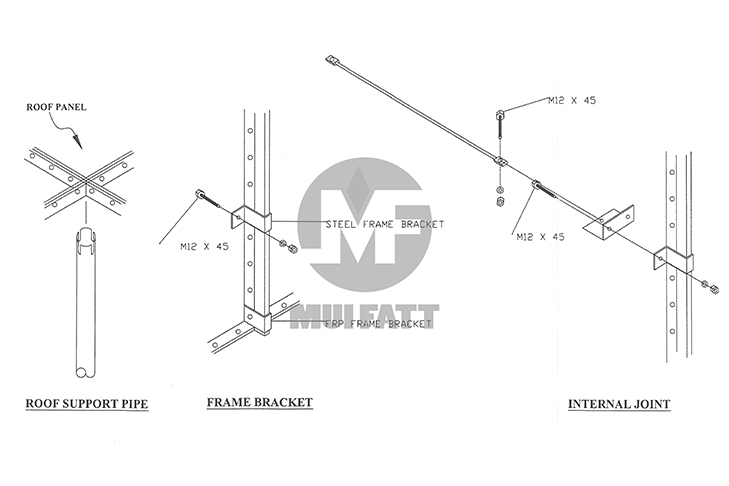
Step 7: Final Bolt Tightening
-
Sequence: base ➝ sides ➝ roof ➝ external supports.
-
Use a torque wrench to compress the sealant strips tightly between the panel flanges.
-
Recheck tank alignment before final tightening.
-
Fully tighten to compress the sealant for water-tightness.
Step 8: Accessories Installation
Once the tank is fully assembled and bolts tightened:
-
Install internal ladder and external ladder.
-
Fit water level indicators and air vents.
Why Choose Mui Fatt’s FRP Tanks?
Mui Fatt’s FRP panel tanks are certified, durable, and designed for local environmental conditions. Our proven installation method ensures structural integrity, leak resistance, and compliance with Malaysian regulations such as SPAN and IKRAM.
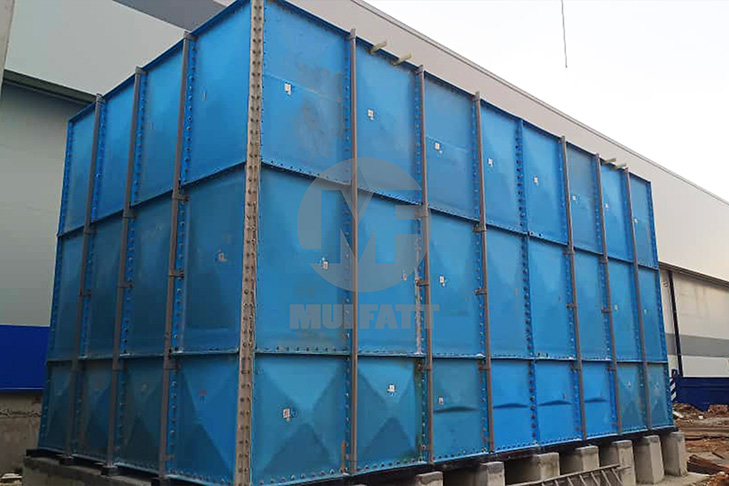
Read more on one of our successful FRP Panel Tank supplies to a data center in Johor - 2025 FRP Sectional Water Tank Supply to Johor Data Center
Frequently Asked Questions (FAQs)
What’s the typical installation time for an FRP panel tank?
Depending on size, most on-site installations are completed within 1–3 days.
Is a concrete plinth necessary for FRP tanks?
Yes, FRP sectional panel tanks must be installed on a properly constructed concrete plinth, not just a flat concrete slab. The plinth provides structural support along the tank’s base perimeter and ensures proper load distribution, anchoring, and long-term stability. The surface must also be level and aligned with the tank’s layout.
Can Mui Fatt assist with on-site supervision or installation?
While Mui Fatt does not carry out on-site installations directly, we collaborate with trusted third-party installers who are experienced in assembling FRP panel tanks according to our specifications. Installation support can be arranged upon request to ensure project quality and compliance.
What is the minimum tank size you can supply?
We customize tanks based on client requirements, including compact space applications.
See also: Customized FRP Panel Tank for Klinik Kesihatan 2, Sendayan
#FRPpaneltankinstallation #GRPtankMalaysia #paneltankassemblyguide #watertanksetup #sectionaltankinstallation #MuiFattpaneltank
Disclaimer:-
The content on this site is for general information and entertainment purposes and does not constitute legal counsel. We strive to keep our information as accurate as possible. However, we make no warranties about the completeness, accuracy, reliability, suitability, or availability with respect to the information contained on this page. You should rely on this information at your own risk. This website may include links to other third-party sites. These links are provided as a convenience to you as a reader, user, or browser only. We make no representation, warranty, or guarantee, nor do we endorse or take responsibility for any of the content of such sites.
Stay in touch with us if you’re interested in hearing from us promptly.
- Website - https://www.muifatt.com.my/home/
- Facebook - https://www.facebook.com/muifattmarketing
- Instagram - https://www.instagram.com/muifattmarketing/
- Google - https://goo.gl/maps/WxVY13gNcaRTS7Jp6
- Youtube - http://www.youtube.com/@MuiFattMarketing
- TikTok - https://www.tiktok.com/@muifattmarketing
- LinkedIn - https://www.linkedin.com/company/mui-fatt-marketing-sdn-bhd-
- Linktree - https://linktr.ee/muifattmarketing
- Shopee - https://www.shopee.com.my/muifattmarketing
- Lazada - https://www.lazada.com.my/shop/mui-fatt-marketing
Recent Blog
FRP Panels vs Traditional Alternatives: The Ultimate Guide to Durability and Sustainability
Explore why FRP (Fiberglass-Reinforced Plastic) panels outperform traditional materials like steel, plywood, and PVC in durability, sustainability, and cost-effectiveness. Discover real-world applications in MyKiosk projects and cold truck panel assembly, where FRP’s superior insulation, corrosion resistance, and lightweight properties deliver long-term benefits.
Comparing FRP Waterproofing with Traditional Systems
Is FRP lamination a better waterproofing method than traditional systems? Explore this complete guide with real project examples and see why FRP is gaining traction across Malaysia.
Benefits of FRP in Food Handling & Processing
With hygiene, durability, and corrosion resistance at its core, FRP (Fibreglass Reinforced Plastic) is becoming a preferred material in the food industry. This article explores why FRP is ideal for food handling equipment such as supermarket fish trays, water tanks, and food factory platforms, plus how Mui Fatt is delivering proven solutions through its successful FRP applications.
Mui Fatt Insights: Advanced Materials for Modern Needs
Is stainless steel the best for wet areas? This article explains why more industries are switching to FRP for its corrosion resistance, hygiene benefits, and longevity, especially in food displays and chemical exposure zones.
How FRP Supports Modern Data Center Infrastructure
Discover how fiberglass-reinforced plastic (FRP) is reshaping data center construction. Learn its key advantages, comparisons with other materials, and where to apply FRP—from rooftop chillers to cooling tanks.
Understanding FRP Filament Winding: Process, Benefits & Comparison
This article explores the FRP filament winding manufacturing method, how it differs from other FRP techniques, why it’s still widely used, and its long-term value for projects like high-strength tanks and cylinders.
Rust Problems? Discover Why FRP Roofing Is the Superior Choice
Tired of dealing with rusted roof panels? Learn how FRP roofing offers a corrosion-free, custom-fit solution — and why it outperforms metal for industrial environments.
